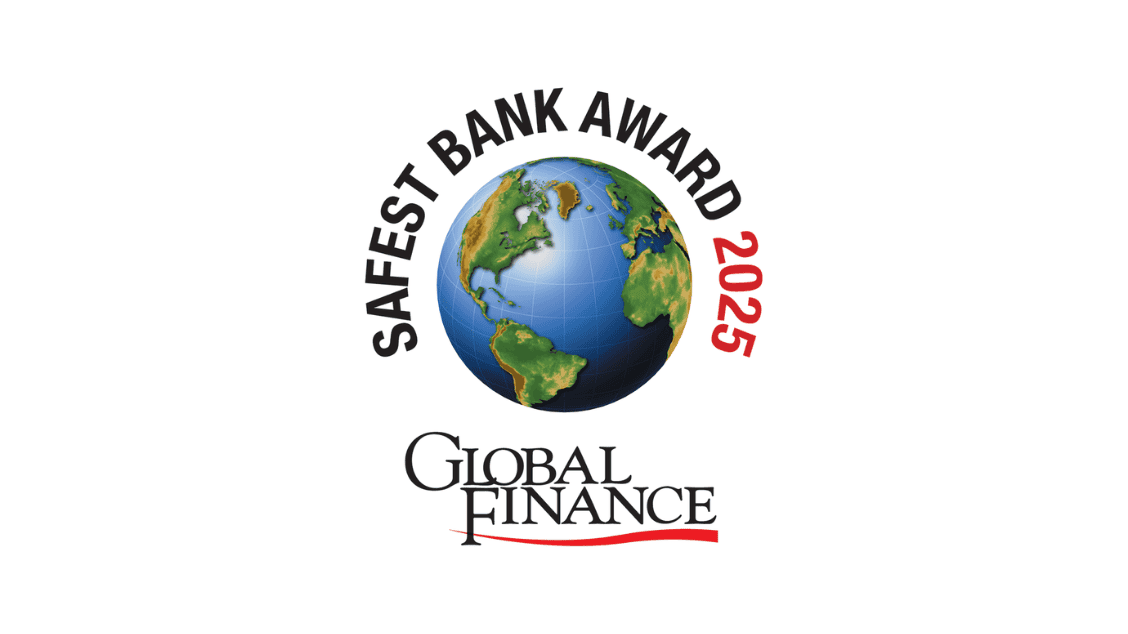Global Finance’s 2025 rankings expand from Global 50 to Global 100 Safest Banks.
The global banking sector faces major challenges as economies worldwide navigate volatility driven by US tariff policies and intensifying competition that is reshaping bank strategies and business models. Against this backdrop, our 2025 rankings expand the World’s Safest Banks from the Global Top 50 to the Top 100, offering a broader view of the sector and deeper insight into its resilience.
Washington’s evolving tariff policy and the resulting disruptions to global trade and supply chains have fractured economic ties among the largest US trading partners, contributing to upward pressure on inflation and to diminished global growth. These represent persistent issues that are likely to grow as the full effects of tariffs take hold. According to the World Trade Organization (WTO), the October forecast for growth in global trade volume in 2025 rose to 2.4% from 0.9% in August, mainly due to the front-loading of imports into the US ahead of announced tariffs. The WTO outlook for 2026, however, is more muted, with trade volume growth falling to 0.5%.
The September economic outlook of the Organization for Economic Cooperation and Development (OECD) projects global GDP growth to decrease from 3.3% in 2024 to 3.2% in 2025, and to 2.9% in 2026. Regionally, growth in the US economy is forecast to fall from 2.8% in 2024 to 1.8% in 2025 and 1.5% in 2026 while euro area GDP growth is expected to be 1.2% in 2025, declining to 1% in 2026. China is facing a possible contraction from 4.9% GDP in 2025 to 4.4% in 2026.
As this year has unfolded, many of the world’s central banks are firmly in an easing cycle, with broadening global rate cuts to spur their respective economies. The institutions at the forefront in providing the most effective service offerings continue to invest in technology to aggressively transform their business models beyond their current digital platforms and online capabilities. Increasingly these banks are utilizing generative artificial intelligence (GenAI) to accelerate this transformation by leveraging data analytics to quickly identify new solutions to drive growth and uncover cost efficiencies.
The Global Top 100
Frequently, changes in a country’s sovereign rating provide the catalyst for year-over-year shifts in our annual rankings. Notably, Moody’s downgraded France to Aa3 from Aa2, citing the country’s fiscal challenges with deficit reduction and weakening public finances. Bank downgrades followed, given reduced government-support uplift to the ratings under the agency’s methodology. Consequently, Caisse des Depots et Consignations fell to No. 29 from No. 11, SFIL dropped to No. 47 from No. 19, BNP Paribas fell to No. 60 from No. 48, Credit Agricole fell to No. 61 from No. 49, and Banque Federative du Credit Mutuel fell to No. 62 from No. 50.
Similarly, following Fitch’s April 2025 downgrade of China due to weakening public finances, follow-on downgrades kept Chinese banks lower in the rankings, with China Development Bank at No. 73, Agricultural Development Bank of China at No. 75, and Export-Import Bank of China at No. 76.
On a positive note, Saudi Arabia benefited from a Moody’s upgrade to Aa3 from A1 in November 2024, with the agency citing progress on economic diversification. S&P recognized the country’s sustained socioeconomic and capital market reforms with a March 2025 upgrade to A+ from A. These moves allowed two banks to enter the top 100: Saudi National Bank at No. 99 and Al Rajhi Bank at No. 100.
In Canada, National Bank of Canada’s progress in growing its franchise to expand beyond its home market of Quebec prompted an S&P upgrade that moved the bank to No. 44 from last year’s No. 68. At Toronto-Dominion Bank, anti-money laundering deficiencies prompted both Moody’s and S&P to downgrade the bank, resulting in a drop in its ranking to No. 41 from No. 21 last year.
Methodology
Our rankings apply to the world’s largest 500 banks by asset size and are calculated based on long-term foreign currency ratings issued by Fitch Ratings, Standard & Poor’s, and Moody’s Investors Service. Under our methodology, we require a rating from at least two of these agencies. It’s important to note that the largest 500 banks with at least two agency ratings are sourced from a universe of approximately 1,000 banks, as not all banks hold two agency ratings. Where possible, ratings on holding companies rather than operating companies are used; and banks that are wholly owned by other banks are omitted. Within each rank set, banks are organized according to asset size, based on data for the most recent annual reporting period provided by Fitch Solutions and Moody’s. Ratings are reproduced with permission from the three rating agencies, with all rights reserved. A ranking is not a recommendation to purchase, sell, or hold a security; and it does not comment on market price or suitability for a particular investor. All ratings in the tables were valid as of August 15, 2025.




